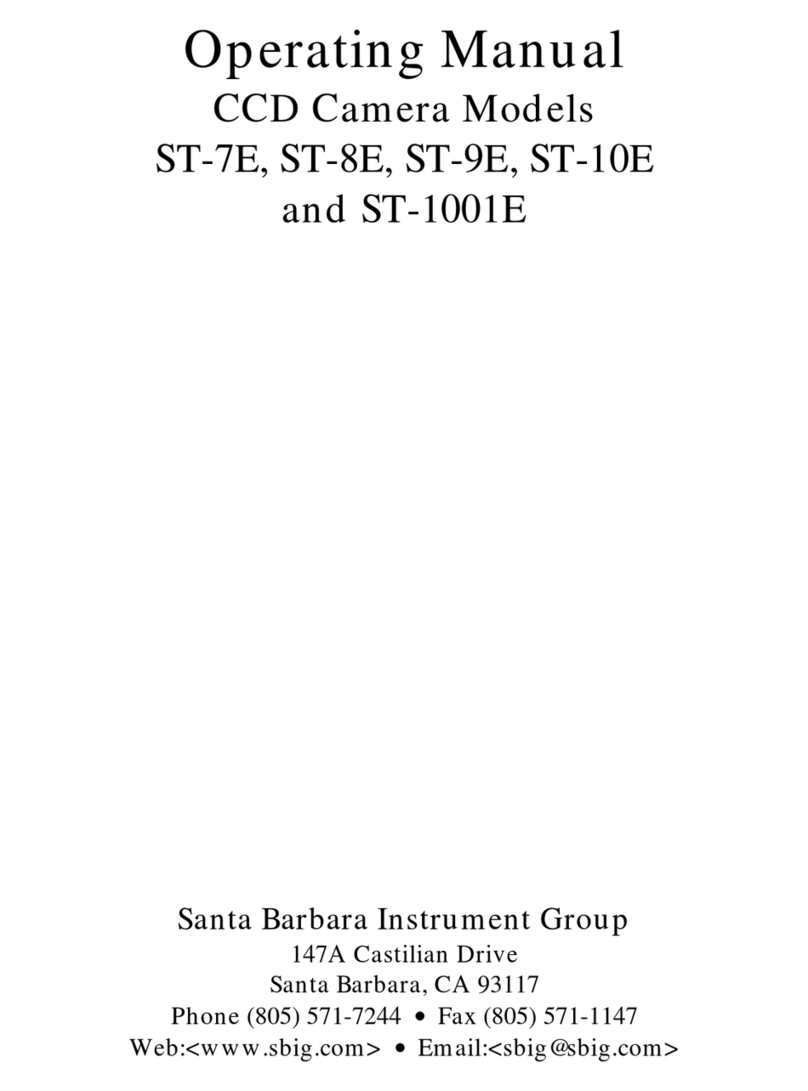
Section 1 - Introduction
Page 1
1. Introduction ..................................................................................................................... 4
1.1. Getting Started .................................................................................................................5
1.1.1. Quick Start Guide – Summary.................................................................... 6
1.1.2. Unpacking the Camera................................................................................ 6
1.1.3. Parts and Assembly ..................................................................................... 9
1.1.4. Connections................................................................................................. 10
1.1.5. Attaching the camera to a telescope using the 2” nosepiece ............... 12
1.1.6. Attaching the camera to a telescope using a custom adapter.............. 12
1.1.7. Attaching the optional camera lens adapter .......................................... 13
1.1.8. Connecting the STL-RC Adapter and Relay Cable ...............................13
1.1.9. Optional Relay Adapter Box.....................................................................14
1.1.10. Attaching the Remote Head ..................................................................... 14
1.1.11. Connecting water hoses ............................................................................15
1.1.12. Extending the USB cable ........................................................................... 15
1.1.13. Opening the Front Cover - Changing Filters.......................................... 16
1.1.14. Regenerating the Desiccant Plug ............................................................. 17
1.1.15. Indicator Lights........................................................................................... 17
1.1.16. Opening the Back Cover - Changing the Fuse....................................... 18
1.1.17. Attaching the Camera Handles................................................................ 18
1.1.18. Camera Resolution..................................................................................... 19
1.1.19. Camera Field of View ................................................................................ 20
1.1.20. Focal Length, Resolution and Field of View .......................................... 21
1.2. Installing the USB Drivers for the First Time ............................................................ 22
1.2.1. Establish Communications with CCDOPS............................................. 22
1.2.2. Capturing Images with the CCD Camera................................................. 23
2. Introduction to CCD Cameras.................................................................................... 25
2.1. Cameras in General ....................................................................................................... 25
2.2. How CCD Detectors Work ........................................................................................... 25
2.2.1. Full Frame and Frame Transfer / Interline CCDs................................. 26
2.3. Camera Hardware Architecture .................................................................................. 26
2.4. CCD Special Requirements .......................................................................................... 29
2.4.1. Cooling......................................................................................................... 29
2.4.2. Double Correlated Sampling Readout .................................................... 29
2.4.3. Dark Frames ................................................................................................ 30
2.4.4. Flat Field Images......................................................................................... 30
2.4.5. Pixels vs. Film Grains................................................................................. 30
2.4.6. Guiding........................................................................................................ 32
2.5. Electronic Imaging......................................................................................................... 32
2.6. Black and White vs. Color ............................................................................................ 33
3. At the Telescope with a CCD Camera ...................................................................... 35
3.1. Step by Step with a CCD Camera................................................................................ 35
3.2. Attaching the Camera to the Telescope...................................................................... 35
3.3. Establishing a Communications Link......................................................................... 35
3.4. Focusing the CCD Camera ........................................................................................... 36
3.5. Finding and Centering the Object ............................................................................... 37
3.6. Taking an Image............................................................................................................. 37

































